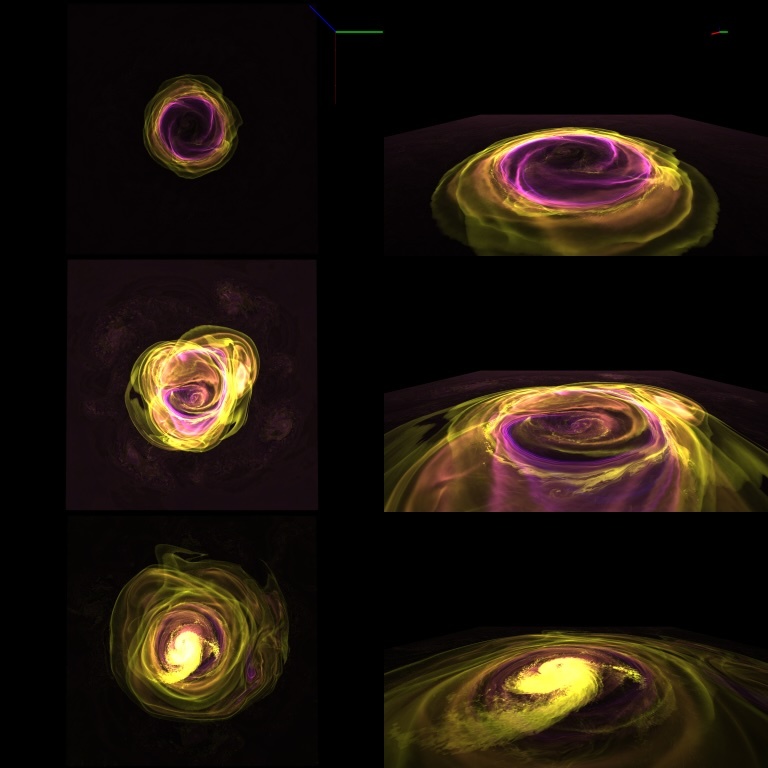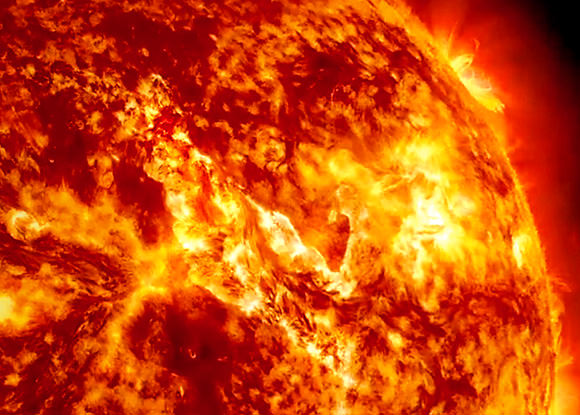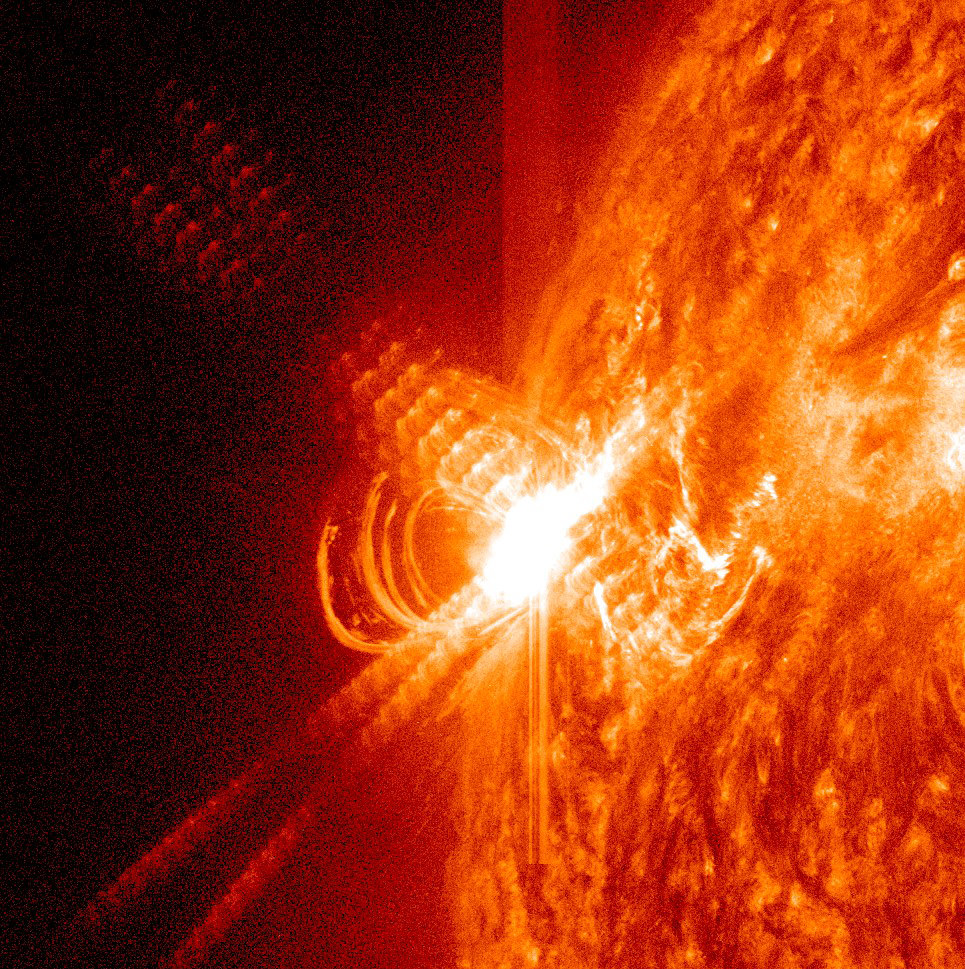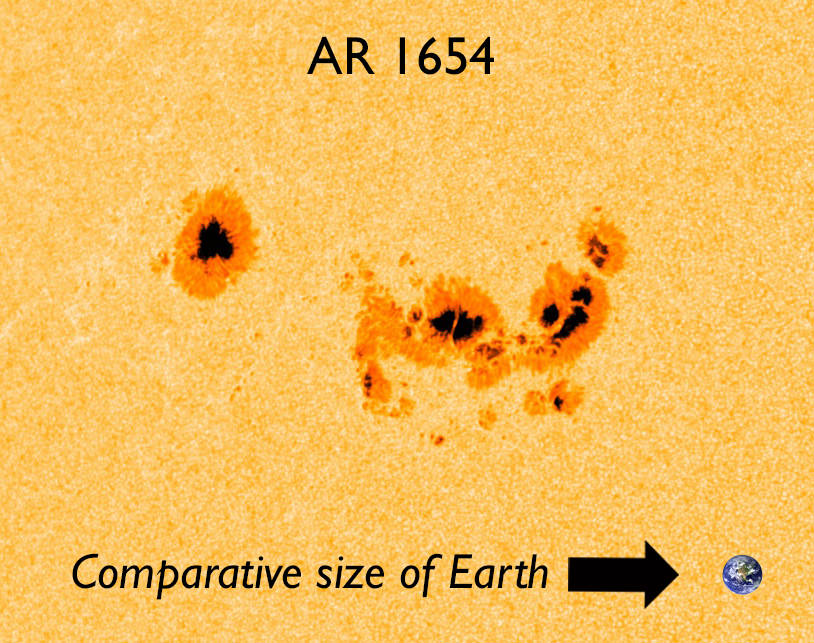The Sun has been vying for attention these last couple of weeks. First with the appearance of a fabulous complex sunspot region and then with a plethora of solar flares. On the 14th May, yet another was released, this time an X8.7 class flare from the same complex sunspot regions. It was significantly more powerful than the flare that set off the aurora displays which enchanted much of the planet but alas it was not pointing toward the Earth ( 🙁 sad emoji face.) Even though it was not directed at us, it could still disrupt communications and electronics but is a reminder that the Sun, whilst is on its way to solar maximum still has lots to give.
Continue reading “The Sun Hurls its Most Powerful Flare in a Decades”It Takes a Supercomputer to Properly Simulate a Neutron Star’s Surface
Neutron stars, the remains of massive stars that have imploded and gone supernova at the end of their life, can still create massive flares. These incredible bursts of energy release X-rays that propagate through space. It is a complex process to simulate but astronomers have turned to a supercomputer to help. Modelling the twisting magnetic fields, the interaction with gas and dust, the surface of flaring neutron stars has been revealed in incredible 3D.
Continue reading “It Takes a Supercomputer to Properly Simulate a Neutron Star’s Surface”What Was the Carrington Event?
Isn’t modern society great? With all this technology surrounding us in all directions. It’s like a cocoon of sweet, fluffy silicon. There are chips in my fitness tracker, my bluetooth headset, mobile phone, car keys and that’s just on my body.
At all times in the Cain household, there dozens of internet devices connected to my wifi router. I’m not sure how we got to the point, but there’s one thing I know for sure, more is better. If I could use two smartphones at the same time, I totally would.
And I’m sure you agree, that without all this technology, life would be a pale shadow of its current glory. Without these devices, we’d have to actually interact with each other. Maybe enjoy the beauty of nature, or something boring like that.
It turns out, that terrible burning orb in the sky, the Sun, is fully willing and capable of bricking our precious technology. It’s done so in the past, and it’s likely to take a swipe at us in the future.
I’m talking about solar storms, of course, tremendous blasts of particles and radiation from the Sun which can interact with the Earth’s magnetosphere and overwhelm anything with a wire.
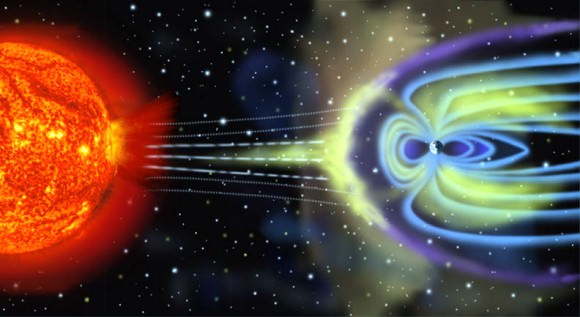
In fact, we got a sneak preview of this back in 1859, when a massive solar storm engulfed the Earth and ruined our old timey technology. It was known as the Carrington Event.
Follow your imagination back to Thursday, September 1st, 1859. This was squarely in the middle of the Victorian age.
And not the awesome, fictional Steampunk Victorian age where spectacled gentleman and ladies of adventure plied the skies in their steam-powered brass dirigibles.
No, it was the regular crappy Victorian age of cholera and child labor. Technology was making huge leaps and bounds, however, and the first telegraph lines and electrical grids were getting laid down.
Imagine a really primitive version of today’s electrical grid and internet.
On that fateful morning, the British astronomer Richard Carrington turned his solar telescope to the Sun, and was amazed at the huge sunspot complex staring back at him. So impressed that he drew this picture of it.
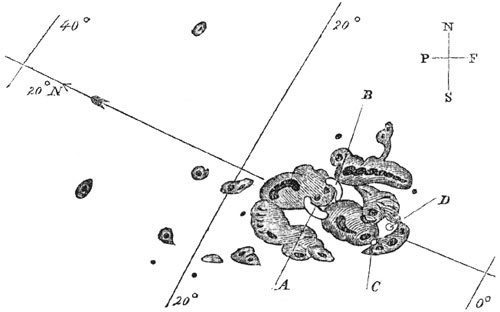
While he was observing the sunspot, Carrington noticed it flash brightly, right in his telescope, becoming a large kidney-shaped bright white flare.
Carrington realized he was seeing unprecedented activity on the surface of the Sun. Within a minute, the activity died down and faded away.
And then about 5 minutes later. Aurora activity erupted across the entire planet. We’re not talking about those rare Northern Lights enjoyed by the Alaskans, Canadians and Northern Europeans in the audience. We’re talking about everyone, everywhere on Earth. Even in the tropics.
In fact, the brilliant auroras were so bright you could read a book to them.
The beautiful night time auroras was just one effect from the monster solar flare. The other impact was that telegraph lines and electrical grids were overwhelmed by the electricity pushed through their wires. Operators got electrical shocks from their telegraph machines, and the telegraph paper lit on fire.
What happened? The most powerful solar flare ever observed is what happened.
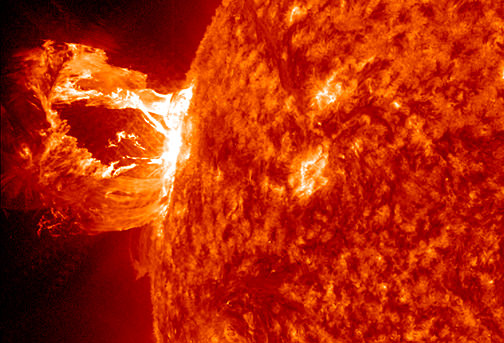
A solar flare occurs because the Sun’s magnetic field lines can get tangled up in the solar atmosphere. In a moment, the magnetic fields reorganize themselves, and a huge wave of particles and radiation is released.
Flares happen in three stages. First, you get the precursor stage, with a blast of soft X-ray radiation. This is followed by the impulsive stage, where protons and electrons are accelerated off the surface of the Sun. And finally, the decay stage, with another burp of X-rays as the flare dies down.
These stages can happen in just a few seconds or drag out over an hour.
Remember those particles hurled off into space? They take several hours or a few days to reach Earth and interact with our planet’s protective magnetosphere, and then we get to see beautiful auroras in the sky.
This geomagnetic storm causes the Earth’s magnetosphere to jiggle around, which drives charges through wires back and forth, burning out circuits, killing satellites, overloading electrical grids.
Back in 1859, this wasn’t a huge deal, when our quaint technology hadn’t progressed beyond the occasional telegraph tower.
Today, our entire civilization depends on wires. There are wires in the hundreds of satellites flying overhead that we depend on for communications and navigation. Our homes and businesses are connected by an enormous electrical grid. Airplanes, cars, smartphones, this camera I’m using.
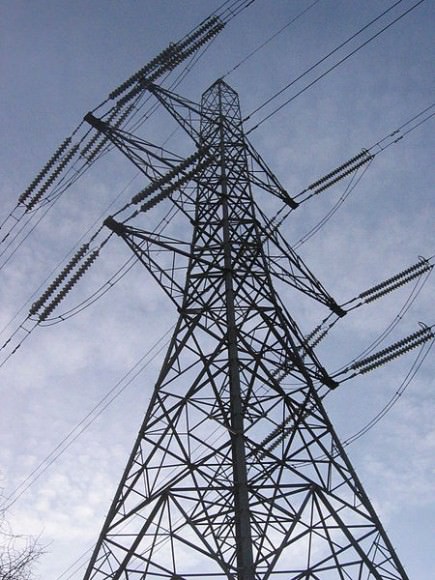
Everything is electronic, or controlled by electronics.
Think it can’t happen? We got a sneak preview back in March, 1989 when a much smaller geomagnetic storm crashed into the Earth. People as far south as Florida and Cuba could see auroras in the sky, while North America’s entire interconnected electrical grid groaned under the strain.
The Canadian province of Quebec’s electrical grid wasn’t able to handle the load and went entirely offline. For 12 hours, in the freezing Quebec winter, almost the entire province was without power. I’m telling you, that place gets cold, so this was really bad timing.
Satellites went offline, including NASA’s TDRS-1 communication satellite, which suffered 250 separate glitches during the storm.
And on July 23, 2012, a Carrington-class solar superstorm blasted off the Sun, and off into space. Fortunately, it missed the Earth, and we were spared the mayhem.
If a solar storm of that magnitude did strike the Earth, the cleanup might cost $2 trillion, according to a study by the National Academy of Sciences.
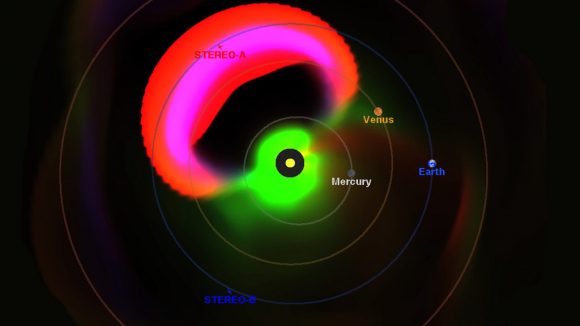
It’s been 160 years since the Carrington Event, and according to ice core samples, this was the most powerful solar flare over the last 500 years or so. Solar astronomers estimate solar storms like this happen twice a millennium, which means we’re not likely to experience another one in our lifetimes.
But if we do, it’ll cause worldwide destruction of technology and anyone reliant on it. You might want to have a contingency plan with some topic starters when you can’t access the internet for a few days. Locate nearby interesting nature spots to explore and enjoy while you wait for our technological civilization to be rebuilt.
Have you ever seen an aurora in your lifetime? Give me the details of your experience in the comments.
Clear Skies Tonight? Go Out and See the Aurora
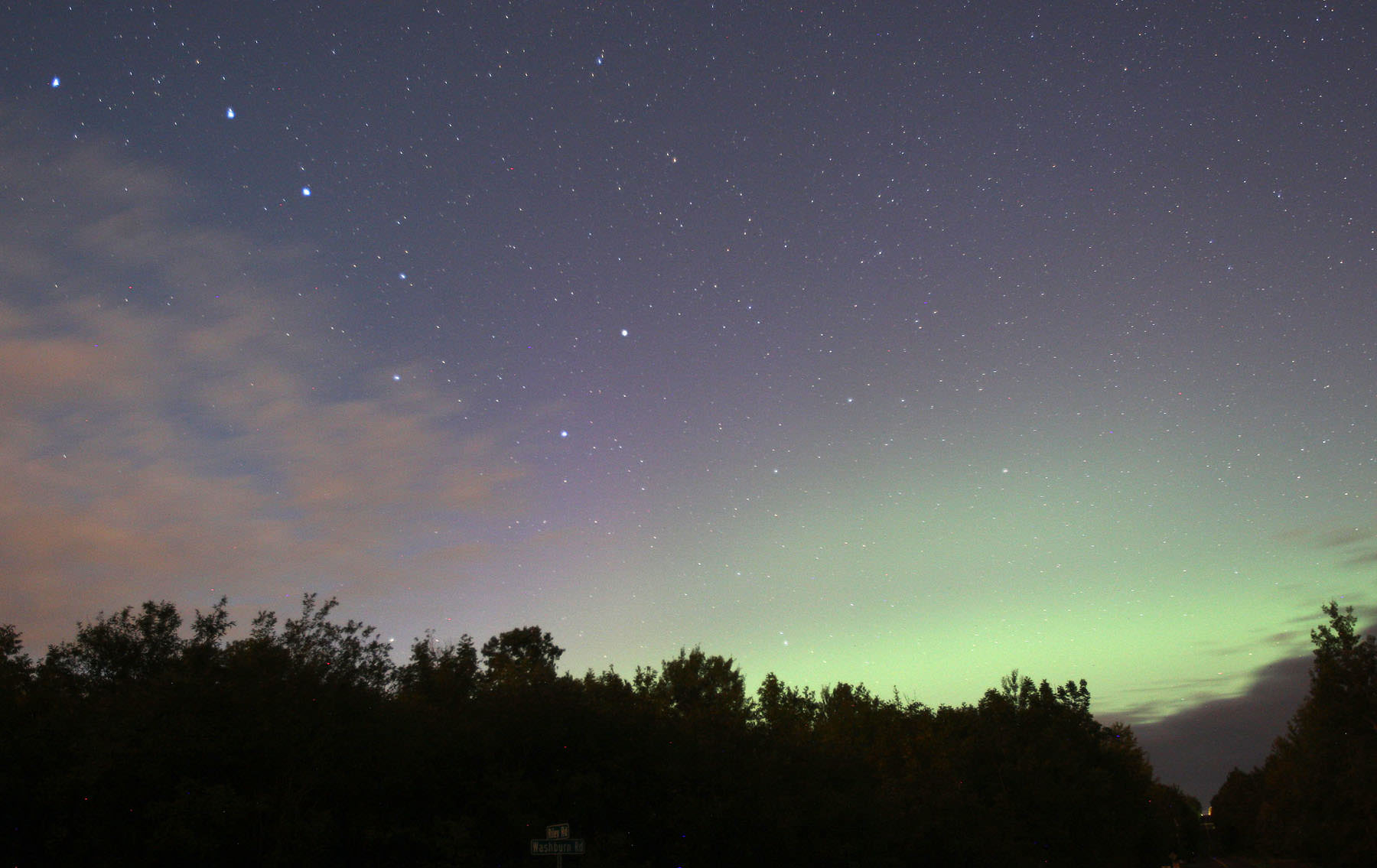
Talk of aurora is in the air. Our earlier story today by Elizabeth Howell alerted you to the possibility of northern lights. Well, it’s showtime! As of 9:30 p.m. Central Daylight Time, the aurora has been active low in the northern sky.
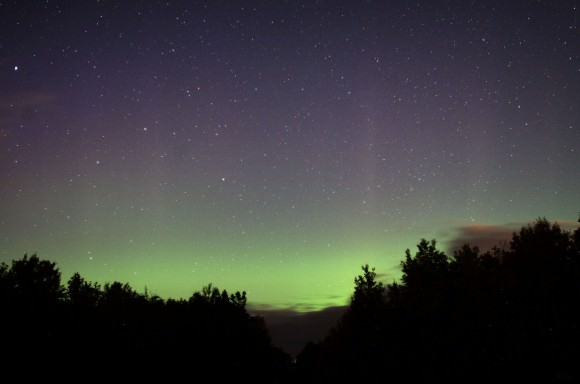
From Duluth, Minn. U.S., a classic green arc low in the northern sky competed with the light of the rising gibbous moon. Once my eyes were dark-adapted, faint parallel rays stood streaked the sky above the arc. NOAA space weather forecasters expect this storm to peak between 1 a.m. CDT and sunrise Friday morning September 12 at a G2 or moderate level. Skywatchers across the northern tier of states and southern Canada should see activity across the northern sky. Moonlight will compromise the show, but it rises later each night and dims through the weekend.
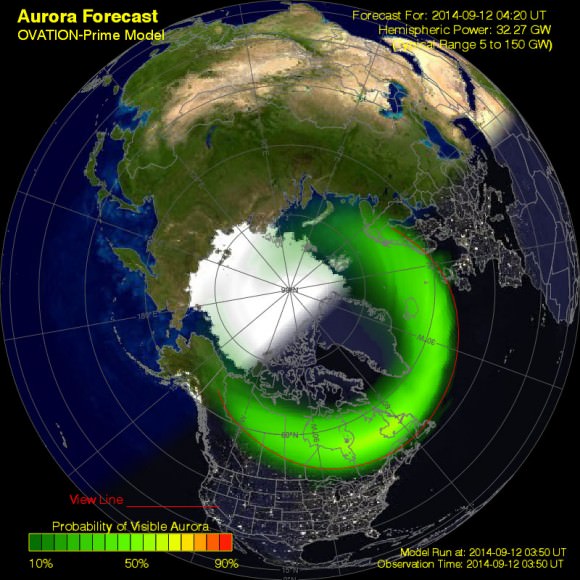
This is only the start. Things really kick into gear Friday night and Saturday morning when a G3 strong geomagnetic storm is expected from the more direct blast sent our way by the September 10 X1.6 flare. Auroras might be visible as far south as Illinois and Kansas.
We’ll keep you in touch with storm activity by posting regular updates over the next couple days. Including odd hours. Here are some links to check during the night as you wait for the aurora to put in an appearance at your house:
* Ovation oval – shows the approximate extent of the auroral oval that looks like a cap centered on Earth’s geomagnetic pole. During storms, the oval extends south into the northern U.S. and farther.
* Kp index – indicator of magnetic activity high overhead and updated every three hours. A Kp index of “5” means the onset of a minor storm; a Kp of “6”, a moderate storm.
* NOAA space weather forecast
* Advanced Composition Explorer (ACE) satellite plots – The magnetic field direction of the arriving wind from the sun. The topmost graph, plotting Bz, is your friend. When the curve drops into the negative zone that’s good! A prolonged stay at -10 or lower increases the chance of seeing the aurora. Negative numbers indicate a south-pointing magnetic field, which has a greater chance of linking into Earth’s northward-pointing field and wriggling its way past our magnetic defenses and sparking auroras.
This Was the Best Watched Solar Flare Ever
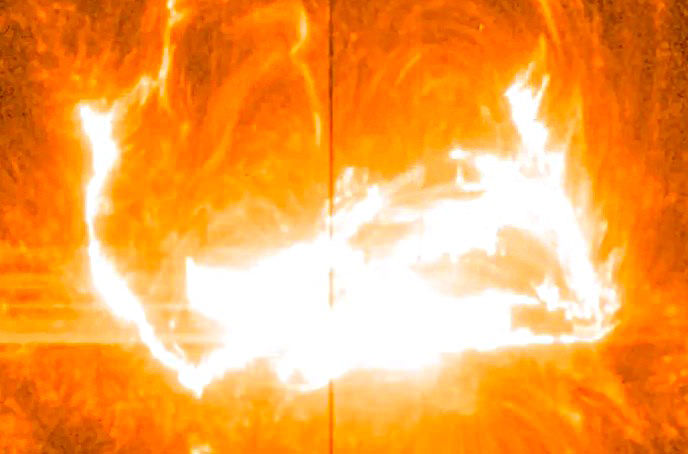
Are giant dragons flying out of the Sun? No, this is much more awesome than that: it’s an image of an X-class flare that erupted from active region 2017 on March 29, as seen by NASA’s Interface Region Imaging Spectrograph (IRIS) spacecraft. It was not only IRIS’s first view of such a powerful flare, but with four other solar observatories in space and on the ground watching at the same time it was the best-observed solar flare ever.
(But it does kind of look like a dragon. Or maybe a phoenix. Ah, pareidolia!)
Check out a video from NASA’s Goddard Space Flight Center below:
In addition to IRIS, the March 29 flare was observed by NASA’s Solar Dynamics Observatory (SDO), NASA’s Reuven Ramaty High Energy Solar Spectroscopic Imager (RHESSI), JAXA and NASA’s Hinode spacecraft, and the National Solar Observatory’s Dunn Solar Telescope in New Mexico.
With each telescope equipped with instruments specially designed to observe the Sun in specific wavelengths almost no detail of this particular flare went unnoticed, giving scientists comprehensive data on the complex behavior of a single solar eruption.
Also, for another look at this flare from SDO and a coronal dimming event apparently associated with it, check out Dean Pesnell’s entry on the SDO is GO! blog here.
Source: NASA/GSFC
Giant sunspot convulses but all quiet on the aurora front … for now
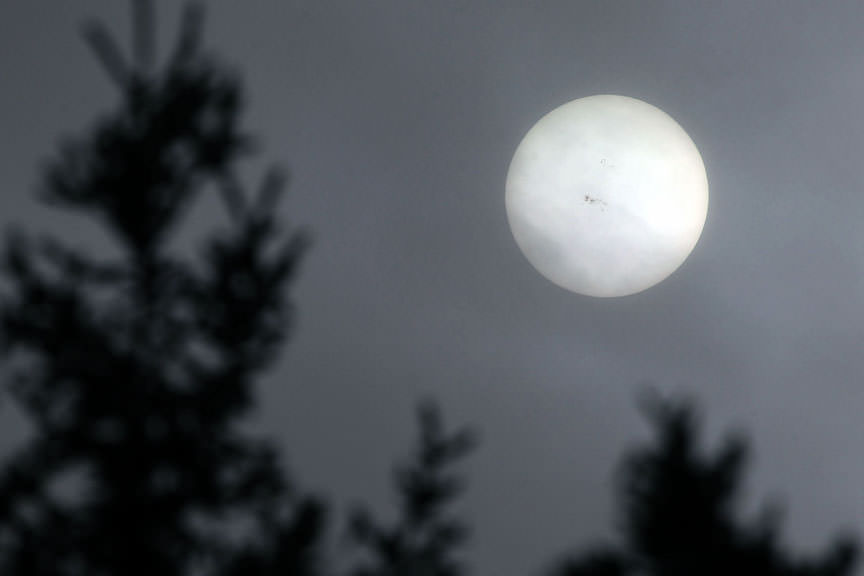
What a crazy sunspot cycle. Weeks go by with only a few tiny spots freckling the sun, then all at once a monster group big enough to swallow 10 Earths rounds the eastern limb and we’re back in business. I’m happy to report we’ve got another behemoth snapping and crackling with M-class (moderately strong) flares – Active Region 1967, a hunk-a-hunk of burnin’ funk that rounded the solar limb a week ago.
NOAA weather forecasters predict an 80% chance of continued M-flares and a 50% chance over the next 3 days for considerably more powerful X-class flares. This sunspot group has a delta classification magnetic field, the Facebook equivalent of “It’s complicated”.
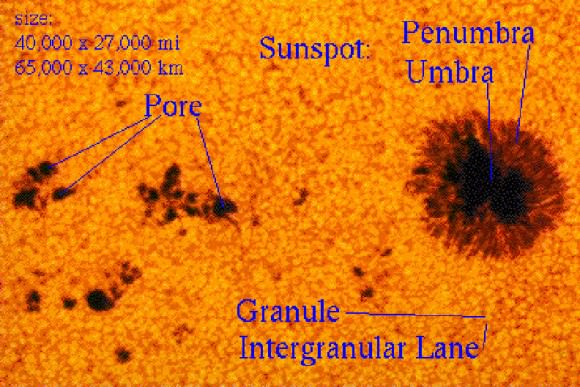
Sunspots have two parts: a dark core (or cores) called an umbra surrounded by a paler skirt of magnetic energy, the penumbra. They can look impressive like this one, but it’s hard to call a sunspot a “thing”. It’s really more of a locale on the sun’s bright white photosphere where bundles of powerful magnetic energy bob up from below the surface and insulate a region of the sun’s fiery hydrogen gas from the rest of the flaming globe.
We’re talking insulate as in staying cool. While the photosphere cooks at around 11,000 degrees Fahrenheit, sunspots are some 3,000 degrees cooler. That’s why they appear dark to the eye. If you could rip them away from the sun and see them alone against the sky, they’d be too bright to look at safely.
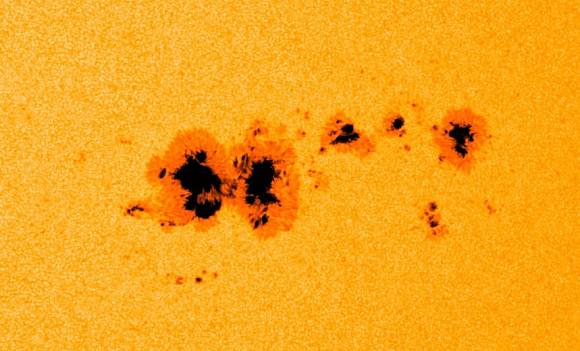
A delta-class spot group has umbrae of both polarities, north and south, corralled within the penumbra. Like bringing opposite poles of a two magnets so close they snap together, something similar can happen inside delta-class groups. Only instead of a snap, a titanic thermonuclear explosion called a flare goes kaboom.The biggest flares release the equivalent of a billion hydrogen bombs.
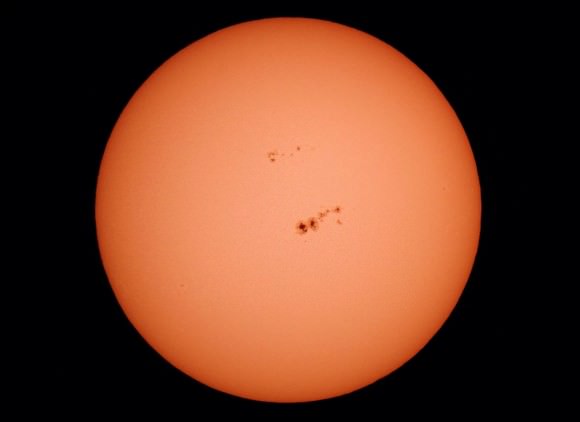
We thank our lucky stars for Earth’s iron heart, which generates our protective magnetic shield, and the 93 million miles that separate us from the sun. AR 1967 has paraded right in front of our noses as it rotated with the sun. Yesterday it squarely faced the Earth – a good thing when it comes to the particle blasts that fire up the northern lights. Let’s hope it showers us with a magnetic goodness in the coming days. I really miss seeing the aurora. You too? NOAA space weather forecasters are calling for a 25% chance of auroras in Arctic latitudes overnight Feb. 4-5. We at mid-latitudes will try to be patient.
Watch the Sun Split Apart
Here’s your amazing oh-my-gosh-space-is-so-cool video of the day — a “canyon of fire” forming on the Sun after the liftoff and detachment of an enormous filament on September 29-30. A new video, created from images captured by the Solar Dynamics Observatory (SDO) and assembled by NASA’s Goddard Space Flight Center, shows the entire dramatic event unfolding in all its mesmerizing magnetic glory.
Watch it below:
Solarrific! (And I highly suggest full-screening it in HD.) That filament was 200,000 miles long, and the rift that formed afterwards was well over a dozen Earths wide!
Captured in various wavelengths of light by SDO’s Atmospheric Imaging Assembly (AIA) the video shows the solar schism in different layers of the Sun’s corona, which varies greatly in temperature at different altitudes.
According to the description from Karen Fox at GSFC:
“The red images shown in the movie help highlight plasma at temperatures of 90,000° F and are good for observing filaments as they form and erupt. The yellow images, showing temperatures at 1,000,000° F, are useful for observing material coursing along the sun’s magnetic field lines, seen in the movie as an arcade of loops across the area of the eruption. The browner images at the beginning of the movie show material at temperatures of 1,800,000° F, and it is here where the canyon of fire imagery is most obvious.”
Now, there’s not really any “fire” on the Sun — that’s just an illustrative term. What we’re actually seeing here is plasma contained by powerful magnetic fields that constantly twist and churn across the Sun’s surface and well up from its interior. The Sun is boiling with magnetic fields, and when particularly large ones erupt from deep below its surface we get the features we see as sunspots, filaments, and prominences.
When those fields break, the plasma they contained gets blasted out into space as coronal mass ejections… and this is what typically happens when one hits Earth. (But it could be much worse.)
Hey, that’s what it’s like living with a star!
Stay up to date on the latest solar events on the SDO mission page here.
These Are Really, Really Big Sunspots Facing Earth Right Now
Do you feel like you’re in the firing gallery? These sunspots are practically square-on to Earth right now. Although they haven’t shown much sign of erupting, if they did our planet would be right in the line of fire if a flare or stream of solar particles erupted.
These groups (known as 1785 and 1787) are so big that they are easily visible in amateur telescopes. 1785 alone is more than 11 Earth-diameters across, according to SpaceWeather.com! Just make sure you have the proper solar filters in place before you gaze at these dark smudges.
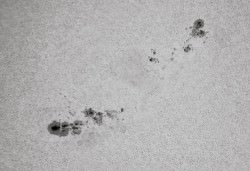
“Sunspots” — so called because they appear as dark smudges on the face of the sun — are areas of intense magnetic activity on the sun (thousands of times stronger than that of Earth’s magnetic field.)
At times, these regions can get so intense that the energy builds up and releases in the form of a flare and/or a coronal mass ejection — a burst of gas and magnetism that hurls solar material away from the sun.
If these flares hit the area of the Earth, a bunch of things can happen. Particles can flow along Earth’s magnetic lines and lead to the creation of aurora, or Northern/Southern lights. (Here’s an aurora that happened in June.) More severe storms can short out satellites or disable power lines.
“Could it be the calm before the storm?” SpaceWeather.com asked on its homepage, before giving forecasts of strong types of flares: “NOAA forecasters estimate a 55% chance of M-flares and a 10% chance of X-flares on July 8.”
The question has more pertinence given that 2013 is supposed to be the peak of the current 11-year sunspot cycle, but so far it’s been quieter than astronomers expected. Scientists are still trying to figure out how the cycle works.
We’ll keep our eyes peeled and let you know if something interesting happens. In the meantime, these pictures came from Universe Today readers, and we’d love to see your images, too! Feel free to add your snapshots to our Flickr page.
Update, 2:39 EDT: Among the pictures in our Flickr pool is this new stunner below from Ron Cottrell of Oro Valley, Arizona. “These sunspots are so magnificent that I get striking detail with my small 40mm Hydrogen-alpha telescope,” he wrote us.
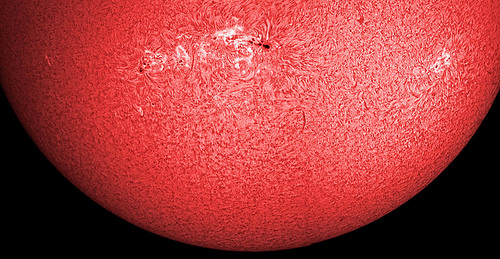
Update, 2:50 p.m. EDT: On Twitter, Daniel Fischer pointed out that the sunspot group is even visible using a simple camera and eclipse glasses.
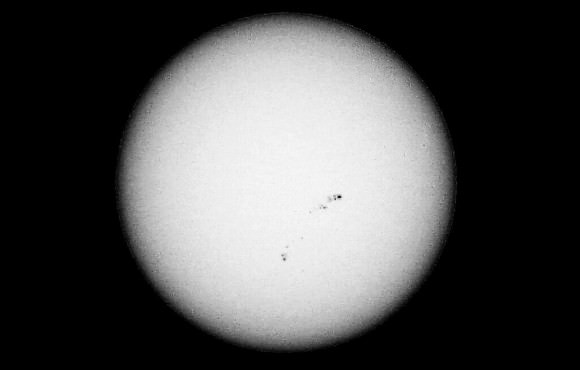
Yet Another X-Class Flare From AR 1748
Last night, as Commander Hadfield and the Expedition 35 crew were returning to Earth in their Soyuz spacecraft, the Sun unleashed yet another X-class flare from active region 1748, the third and most powerful eruption yet from the sunspot region in the past 24 hours — in fact, at a level of X3.2, it was the most intense flare observed all year.
And with this dynamic sunspot region just now coming around the Sun’s limb and into view, we can likely expect much more of this sort of activity… along with a steadily increasing chance of an Earth-directed CME.
According to SpaceWeather.com AR1748 has produced “the strongest flares of the year so far, and they signal a significant increase in solar activity. NOAA forecasters estimate a 40% chance of more X-flares during the next 24 hours.”
(Find out more about the classification of solar flares here.)
The sunspot region just became fully visible to Earth during the early hours of May 13 (UT).
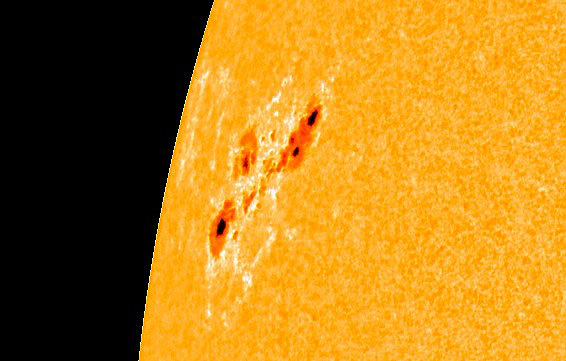
Sunspots are regions where the Sun’s internal magnetic fields rise up through its surface layers, preventing convection from taking place and creating cooler, optically darker areas. They often occur in pairs or clusters, with individual spots corresponding to the opposite polar ends of magnetic lines.
Sunspots may appear dark because they are relatively cooler than the surrounding area on the Sun’s photosphere, but in ultraviolet and x-ray wavelengths they are brilliantly white-hot. And although sunspots look small compared to the Sun, they are often many times larger than Earth.
Read more: How Big Are Sunspots?
According to SDO project scientists Dean Pesnell on the SDO is Go! blog, AR1748 is not only rapidly unleashing flares but also changing shape.
“The movies show that the sunspot is changing, the two small groups on the right merging and the elongated spot on the lower left expanding out to join them,” Pesnell wrote earlier today.
Of course, as a solar scientist Pesnell is likely much more excited about the chance to observe further high-intensity activity than he is concerned about any dramatically negative impacts of a solar storm here on Earth, which, although possible, are still statistically unlikely.
“Great times ahead for this active region!” he added enthusiastically.
For updated information on AR1748’s activity visit SpaceWeather.com and NASA’s SDO site, and also check out TheSunToday.org run by solar physicist C. Alex Young, Ph.D.
Images courtesy of NASA/SDO and the AIA, EVE, and HMI science teams.
AR1654 is a Monster Sunspot. (And It’s Aiming Our Way.)
Active Region 1654 on the Sun’s western limb, seen by SDO on Jan. 11 (NASA/SDO/HMI team. Diagram by J. Major.)
Like an enormous cannon that is slowly turning its barrel toward us, the latest giant sunspot region AR1654 is steadily moving into position to face Earth, loaded with plenty of magnetic energy to create M-class flares — moderate-sized outbursts of solar energy that have the potential to cause brief radio blackouts on Earth and, at the very least, spark bright aurorae around the upper latitudes.
According to SpaceWeather.com, AR1654 “could be the sunspot that breaks the recent lengthy spell of calm space weather around our planet.”
The image above, captured by NASA’s Solar Dynamics Observatory earlier today, shows the structure of AR1654 upon the Sun’s photosphere — its light-emitting “surface” layer. Stretching many tens of thousands of miles, this magnetic solar blemish easily dwarfs our entire planet. And it’s not just a prediction that this sunspot will unleash a flare — it already has.
AR1654 came around the limb of the sun crackling with activity. Shortly after the probability of AR1654 releasing a flare was raised to 50% it did just that, letting loose with a burst of magnetic energy that was observed by SDO’s multi-channel cameras. Watch the video below:
Peaking at 9:11 UTC, this M1-class flare won’t have much more effect on Earth than perhaps some radio and GPS interference and maybe increased auroral activity. But AR1654 is still evolving and growing… and moving to face us.
In the meantime, solar astronomers and observatories like SDO are keeping an ever-watchful eye on this magnetic monster.
Keep up with the latest news here on Universe Today, on the SDO mission site and on spaceweather.com.
UPDATE 1/12: According to the NOAA, AR1654 has a 5% chance of producing an X-class flare, based on its current magnetic activity and alignment.
A sunspot is a magnetically active region on the sun that appears dark because it’s relatively cooler than the surrounding area—6,000ºF (3,300ºC) versus 10,000ºF (5,500º C). Sunspots are where solar flares are most likely to occur since the magnetic fields in these active regions can build up enough energy to break, releasing bursts of intense radiation into the solar system.


